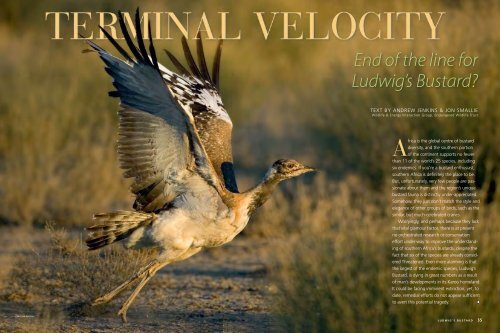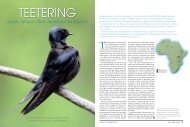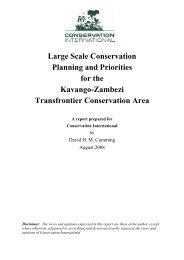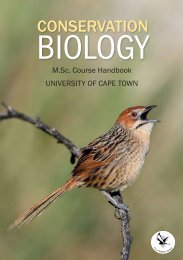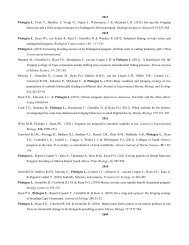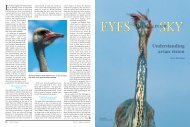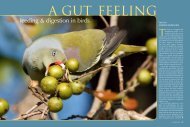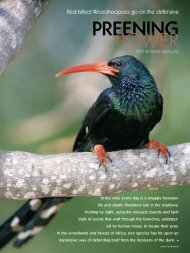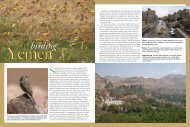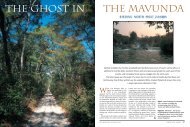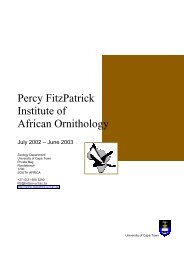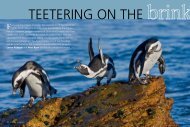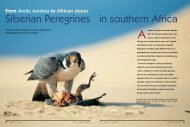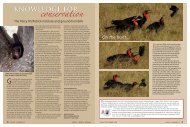End of the line for Ludwig's Bustard?
End of the line for Ludwig's Bustard?
End of the line for Ludwig's Bustard?
You also want an ePaper? Increase the reach of your titles
YUMPU automatically turns print PDFs into web optimized ePapers that Google loves.
chris van rooyen<br />
<strong>End</strong> <strong>of</strong> <strong>the</strong> <strong>line</strong> <strong>for</strong><br />
Ludwig’s <strong>Bustard</strong>?<br />
TexT by Andrew Jenkins & Jon smAllie<br />
wildlife & energy interaction Group, endangered wildlife Trust<br />
Africa is <strong>the</strong> global centre <strong>of</strong> bustard<br />
diversity, and <strong>the</strong> sou<strong>the</strong>rn portion<br />
<strong>of</strong> <strong>the</strong> continent supports no fewer<br />
than 11 <strong>of</strong> <strong>the</strong> world’s 25 species, including<br />
six endemics. if you’re a bustard enthusiast,<br />
sou<strong>the</strong>rn Africa is definitely <strong>the</strong> place to be.<br />
but, un<strong>for</strong>tunately, very few people are passionate<br />
about <strong>the</strong>m and <strong>the</strong> region’s unique<br />
bustard fauna is distinctly under-appreciated.<br />
somehow, <strong>the</strong>y just don’t match <strong>the</strong> style and<br />
elegance <strong>of</strong> o<strong>the</strong>r groups <strong>of</strong> birds, such as <strong>the</strong><br />
similar, but much-celebrated cranes.<br />
worryingly, and perhaps because <strong>the</strong>y lack<br />
that vital glamour factor, <strong>the</strong>re is at present<br />
no orchestrated research or conservation<br />
ef<strong>for</strong>t under way to improve <strong>the</strong> understanding<br />
<strong>of</strong> sou<strong>the</strong>rn Africa’s bustards, despite <strong>the</strong><br />
fact that six <strong>of</strong> <strong>the</strong> species are already considered<br />
Threatened. even more alarming is that<br />
<strong>the</strong> largest <strong>of</strong> <strong>the</strong> endemic species, ludwig’s<br />
bustard, is dying in great numbers as a result<br />
<strong>of</strong> man’s developments in its karoo homeland.<br />
it could be facing imminent extinction, yet, to<br />
date, remedial ef<strong>for</strong>ts do not appear sufficient<br />
to avert this potential tragedy.<br />
<br />
ludwig’s bustard<br />
35
Collision course<br />
Ludwig’s <strong>Bustard</strong> Neotis ludwigii is a Karoo species,<br />
preferring open, plains country, where<br />
it can wander around, picking insects, small<br />
reptiles and bits <strong>of</strong> vegetation from <strong>the</strong> stony<br />
ground. It typically occurs in loose flocks,<br />
aggregating to roost on hilltops overnight, and<br />
moving haphazardly with <strong>the</strong> seasons, following<br />
<strong>the</strong> plentiful aftermath <strong>of</strong> rain in this semidesert<br />
environment.<br />
There are probably fewer than 80 000 <strong>of</strong> <strong>the</strong>se<br />
ra<strong>the</strong>r ponderous, seemingly absent-minded<br />
no mads left in <strong>the</strong> world, all contained within<br />
an area <strong>of</strong> less than 400 000 square kilo metres.<br />
While <strong>the</strong>ir Karoo habitat has generally been<br />
spared <strong>the</strong> ravages <strong>of</strong> industrial and agricultural<br />
development, and is big and sparse<br />
enough to absorb most <strong>of</strong> what has come its<br />
way to date, it accommodates thousands <strong>of</strong><br />
kilometres <strong>of</strong> overhead power and telephone<br />
<strong>line</strong>s. The South African national power grid<br />
comprises a backbone <strong>of</strong> massive, high-voltage<br />
<strong>line</strong>s, branching into a complex grid <strong>of</strong> smaller,<br />
lower voltage distribution and reticulation<br />
<strong>line</strong>s, and is crucial to sustaining <strong>the</strong> country’s<br />
economic growth. Un<strong>for</strong>tunately, it is also a<br />
lethal trap <strong>for</strong> bustards.<br />
Biologists and power utilities around <strong>the</strong><br />
world have known <strong>for</strong> decades that power<br />
<strong>line</strong>s can be hazardous <strong>for</strong> birds, and that<br />
many species suffer significant casualties<br />
in collisions with high-tension wires and<br />
cables. Such collisions seem to occur particularly<br />
in situations where <strong>the</strong> height, configuration<br />
and situation <strong>of</strong> <strong>the</strong> <strong>line</strong>s, which affect<br />
<strong>the</strong>ir visibility and <strong>the</strong> extent to which <strong>the</strong>y<br />
impinge on popular flight paths <strong>of</strong> birds, all<br />
conspire against <strong>the</strong> prevailing avian traffic.<br />
Also, certain types <strong>of</strong> birds (notably bustards,<br />
cranes, storks, raptors, waterfowl and gamebirds)<br />
are more susceptible to hitting power<br />
<strong>line</strong>s. Topping <strong>the</strong> list are large, heavy-bodied,<br />
terrestrial species, probably because <strong>the</strong>y <strong>of</strong>ten<br />
mark d. anderson (2)<br />
fly cross-country at fairly low altitudes, within<br />
<strong>the</strong> elevation ranges <strong>of</strong> even <strong>the</strong> smaller <strong>line</strong>s,<br />
and because <strong>the</strong>y are relatively clumsy fliers,<br />
with a lot <strong>of</strong> <strong>for</strong>ward momentum and not<br />
much manoeuvrability.<br />
Aerial agility is largely a function <strong>of</strong> wing<br />
loading (<strong>the</strong> ratio <strong>of</strong> body weight to wing surface<br />
area), and chunky-bodied birds with small<br />
wings are <strong>of</strong>ten not sufficiently dexterous to<br />
avoid obstacles at short notice. The biggest<br />
bustards take this equation to its extreme: Kori<br />
Ardeotis kori and Great Otis tarda bustards are<br />
among <strong>the</strong> world’s heaviest flying birds and,<br />
although <strong>the</strong>y do regularly collide with overhead<br />
<strong>line</strong>s, <strong>the</strong>y may be saved to some extent<br />
by <strong>the</strong>ir predominantly terrestrial existence<br />
and <strong>the</strong>ir general reluctance to fly. Ludwig’s<br />
<strong>Bustard</strong>, on <strong>the</strong> o<strong>the</strong>r hand, while also a big,<br />
heavy bird, is slightly lighter on <strong>the</strong> wing and is<br />
far more mobile than <strong>the</strong> Kori. However, while<br />
this means it is more likely to encounter power<br />
<strong>line</strong>s while flying, it is still almost incapable <strong>of</strong><br />
making <strong>the</strong> rapid changes <strong>of</strong> direction needed<br />
to avoid fatal collisions. These qualities are<br />
compounded by <strong>the</strong> Ludwig’s tendency to fly<br />
in flocks, which introduces <strong>the</strong> possibility <strong>of</strong><br />
multiple casualties in single-collision incidents,<br />
and its propensity <strong>for</strong> flying to and from roosts<br />
in <strong>the</strong> dim light <strong>of</strong> dusk and dawn, when conditions<br />
<strong>for</strong> seeing power <strong>line</strong>s are arguably at<br />
<strong>the</strong>ir worst.<br />
In grassland habitats, <strong>the</strong> very similar Denham’s<br />
<strong>Bustard</strong> N. denhami replaces Ludwig’s,<br />
but is more widely distributed and far less<br />
inc<strong>line</strong>d to long-distance movements, so it is<br />
probably not as collision-prone. All things considered,<br />
Ludwig’s <strong>Bustard</strong> may have <strong>the</strong> worst<br />
avian collision risk pr<strong>of</strong>ile on record.<br />
The scale <strong>of</strong> <strong>the</strong> problem<br />
For more than 12 years, <strong>the</strong> <strong>End</strong>angered<br />
Wildlife Trust (EWT) has worked in partnership<br />
with <strong>the</strong> South African power utility, Eskom, to<br />
collate, monitor and mitigate wildlife mortalities<br />
on existing power <strong>line</strong>s, and to ensure that<br />
all new infrastructure built is as ‘bird-friendly’<br />
as possible. All recorded and reported incidents<br />
are added to <strong>the</strong> Partnership’s Central Incident<br />
Register (CIR) <strong>for</strong> evaluation and feedback on<br />
possible required management and mitigation.<br />
To date, <strong>the</strong> CIR holds about 3 000 mortality<br />
records, <strong>of</strong> which just less than 10 per cent<br />
are Ludwig’s <strong>Bustard</strong> collisions. This figure is<br />
in itself a concern, given that only a fraction<br />
<strong>of</strong> all collision victims are actually picked up<br />
and reported.<br />
But, when examined more closely, <strong>the</strong> true<br />
gravity <strong>of</strong> <strong>the</strong> Ludwig’s <strong>Bustard</strong>’s situation<br />
becomes apparent. In <strong>the</strong> only properly quantified<br />
study <strong>of</strong> avian collision rates on South<br />
African power <strong>line</strong>s, conducted in <strong>the</strong> eastern<br />
Karoo in <strong>the</strong> late 1990s (and funded by<br />
Eskom), Mark Anderson recorded about two<br />
Ludwig’s <strong>Bustard</strong> collisions per kilometre <strong>of</strong><br />
high-voltage <strong>line</strong> per year. More recently,<br />
repeat surveys <strong>of</strong> one <strong>of</strong> Anderson’s focal<br />
<strong>line</strong>s by Ronelle Visagie and Bradley Gibbons<br />
<strong>of</strong> <strong>the</strong> EWT are producing equally concerning<br />
results. Although Eskom has invested a huge<br />
amount <strong>of</strong> resources into <strong>the</strong> development<br />
and implementation <strong>of</strong> mitigation measures<br />
at <strong>the</strong>se and o<strong>the</strong>r collision sites, <strong>the</strong> ongoing<br />
mortalities are cause <strong>for</strong> concern and point to<br />
<strong>the</strong> need to increase our response drastically.<br />
Anderson’s was also <strong>the</strong> only significant<br />
local attempt to test <strong>the</strong> efficiency <strong>of</strong> various<br />
marking devices being used to make power<br />
<strong>line</strong>s more obvious to birds (and hence lower<br />
<strong>the</strong> likelihood <strong>of</strong> collisions). The markers are<br />
generally ei<strong>the</strong>r static coils <strong>of</strong> wire (birdflight<br />
diverters, also known as ‘pigtails’), or<br />
teardrop shapes suspended loosely from <strong>the</strong><br />
<strong>line</strong> and able to flap about in <strong>the</strong> wind (birdflappers).<br />
Both <strong>of</strong> <strong>the</strong>se devices are positioned<br />
at intervals along problem sections <strong>of</strong> <strong>line</strong>,<br />
usually on <strong>the</strong> higher, thinner earth-wire,<br />
which poses <strong>the</strong> greatest threat to overflying<br />
birds. The Karoo study showed that while<br />
both markers available at that time were<br />
reasonably effective in reducing Blue Crane<br />
collisions, <strong>the</strong>y had no noticeable effect on<br />
Ludwig’s <strong>Bustard</strong> casualties. Subsequent to<br />
this study, several new variations on <strong>the</strong>se<br />
markers have been developed by Eskom and<br />
its suppliers, and anecdotal evidence <strong>of</strong> some<br />
success in reducing bustard collisions at certain<br />
sites has emerged. However, it is clear <br />
Above Occasionally, <strong>the</strong><br />
mechanics <strong>of</strong> a bird/power<strong>line</strong><br />
collision are such that <strong>the</strong><br />
victim dies hanging from <strong>the</strong><br />
<strong>line</strong>. Typically, this Ludwig’s<br />
<strong>Bustard</strong> struck <strong>the</strong> higher,<br />
thinner earth-wire <strong>of</strong> a major<br />
transmission <strong>line</strong>, and paid<br />
<strong>the</strong> ultimate price.<br />
Opposite The massive,<br />
high-tension power <strong>line</strong>s that<br />
traverse <strong>the</strong> Karoo are crucial<br />
infrastructural links, carrying<br />
power from source to user.<br />
Un<strong>for</strong>tunately, <strong>the</strong>y are also<br />
deathtraps <strong>for</strong> large terrestrial<br />
birds.<br />
Opposite, inset Eskom has<br />
fitted static ‘bird-flight diverters’<br />
(pigtails) or dynamic<br />
‘bird-flappers’ to problem<br />
<strong>line</strong>s in many areas in an<br />
ef<strong>for</strong>t to reduce <strong>the</strong> frequency<br />
<strong>of</strong> bird collisions.<br />
Previous spread All power<br />
and <strong>for</strong>ward momentum,<br />
a Ludwig’s <strong>Bustard</strong> takes to<br />
<strong>the</strong> air. Built <strong>for</strong> carrying its<br />
considerable bulk over <strong>the</strong><br />
vastness <strong>of</strong> <strong>the</strong> open Karoo,<br />
<strong>the</strong> bustard’s airframe is illequipped<br />
<strong>for</strong> rapid evasive<br />
manoeuvres. Collisions with<br />
aerial obstacles seem almost<br />
inevitable.<br />
36 ludwig’s bustard africa – birds & birding<br />
april/may 2009 ludwig’s bustard 37<br />
koos de goede
Ludwig’s <strong>Bustard</strong> may be<br />
more collision-prone than<br />
o<strong>the</strong>r large bustards because<br />
<strong>of</strong> its greater tendency to<br />
fly. Researchers need to<br />
know far more about where,<br />
when and why individuals<br />
undertake <strong>the</strong>ir movements,<br />
so that an effective strategy<br />
to reduce bustard deaths on<br />
power <strong>line</strong>s can be developed.<br />
Satellite telemetry<br />
may hold <strong>the</strong> key.<br />
that we do not yet have an adequate solution,<br />
despite already using <strong>the</strong> state-<strong>of</strong>-<strong>the</strong>-art<br />
devices available globally.<br />
While <strong>the</strong> bustard death rates recorded near<br />
De Aar may represent extreme collision ‘hotspots’<br />
and <strong>the</strong> overall average may be considerably<br />
lower, with more than 16 000 kilometres<br />
<strong>of</strong> medium-high voltage power <strong>line</strong> in <strong>the</strong><br />
Karoo and even more low-voltage and telephone<br />
<strong>line</strong>s, <strong>the</strong> total Ludwig’s <strong>Bustard</strong> casualty<br />
count every year could be huge. We don’t have<br />
sufficient accurate life-history in<strong>for</strong>mation to<br />
assess fully <strong>the</strong> impact <strong>of</strong> such heavy losses on<br />
<strong>the</strong> population as a whole, but we probably do<br />
know enough about large, long-lived and slowreproducing<br />
birds to be sure that unnatural<br />
mortality rates <strong>of</strong> as much as 10 to 20 per cent<br />
per annum cannot be sustainable. Without<br />
<strong>the</strong> benefit <strong>of</strong> rapid and effective intervention,<br />
future prospects <strong>for</strong> Ludwig’s <strong>Bustard</strong> look ex -<br />
tremely grim.<br />
What can be done?<br />
chris van rooyen<br />
This was <strong>the</strong> question asked in March 2008<br />
at a birds-and-power-<strong>line</strong>s research strategy<br />
workshop hosted by <strong>the</strong> EWT’s Wildlife and<br />
Energy Interaction Group (which incorporates<br />
<strong>the</strong> Eskom-EWT Strategic Partnership), and<br />
attended by a panel <strong>of</strong> local crane, bustard<br />
and raptor biologists. What could accurately<br />
be called <strong>the</strong> ‘bustard crisis’ emerged clearly<br />
as <strong>the</strong> most pressing issue on <strong>the</strong> workshop’s<br />
agenda, and a wishlist <strong>of</strong> bustard research was<br />
drawn up, focused on finding a way to reduce<br />
collision frequency. Top <strong>of</strong> <strong>the</strong> list was <strong>the</strong> need<br />
to update and refine our estimate <strong>of</strong> <strong>the</strong> size <strong>of</strong><br />
<strong>the</strong> Ludwig’s <strong>Bustard</strong> population, and to compare<br />
this estimate with <strong>the</strong> figure calculated by<br />
David Allan more than 15 years ago.<br />
This should give us an idea <strong>of</strong> <strong>the</strong> extent<br />
<strong>of</strong> any dec<strong>line</strong> in numbers, and <strong>the</strong> time we<br />
still have available to stem <strong>the</strong> tide. We also<br />
enigmatic wanderer<br />
ludwig’s is <strong>the</strong> third-largest bustard in sou<strong>the</strong>rn Africa, with<br />
males weighing up to six kilograms. The species is named after<br />
a Cape Town pharmacist, German-born baron von ludwig, who<br />
was an active amateur naturalist in <strong>the</strong> region in <strong>the</strong> early 1800s.<br />
despite its size and relative conspicuousness on <strong>the</strong> open plains <strong>of</strong><br />
<strong>the</strong> karoo, ludwig’s bustard is remarkably little known, and critical<br />
areas <strong>of</strong> its life, in particular <strong>the</strong> details <strong>of</strong> its seasonal movements,<br />
remain frustratingly mysterious.<br />
we know that it is a semi-desert specialist that generally occurs<br />
in small groups, walking and feeding toge<strong>the</strong>r on insects, fruits and<br />
leaves in roughly <strong>the</strong> same area. These small bands collect to <strong>for</strong>m<br />
larger ga<strong>the</strong>rings at designated, hill-top roost sites. we also know that<br />
ludwig’s, like most bustard species, is a polygynous breeder, with <strong>the</strong><br />
adult males, which are far larger than <strong>the</strong> females, going it alone every<br />
breeding season at carefully selected display sites scattered across <strong>the</strong><br />
landscape. They puff <strong>the</strong>mselves up into giant, white-fea<strong>the</strong>red balls,<br />
and boom out <strong>the</strong>ir throaty love songs to prospective mates. After<br />
identified <strong>the</strong> need to start measuring bustard<br />
collision rates across <strong>the</strong> whole range <strong>of</strong> Karoo<br />
habitats (ra<strong>the</strong>r than continuing to base our<br />
approach on data ga<strong>the</strong>red from a single site).<br />
In addition, we need to improve our knowledge<br />
<strong>of</strong> Ludwig’s <strong>Bustard</strong> movements, so that<br />
any pattern or predictable scenario in relation<br />
to <strong>the</strong> national power grid can be used to<br />
enhance whatever collision-mitigation plan we<br />
devise. Finally, we realised <strong>the</strong> need to deepen<br />
our understanding <strong>of</strong> exactly how bustards<br />
perceive power <strong>line</strong>s, why <strong>the</strong>y collide with<br />
<strong>the</strong>m, and how to make <strong>the</strong> <strong>line</strong>s more obvious<br />
to flying birds.<br />
The first couple <strong>of</strong> our objectives should be<br />
relatively straight<strong>for</strong>ward; some <strong>of</strong> <strong>the</strong> bustard<br />
population data may already be available, and<br />
we have begun setting up strategically positioned<br />
study sites to monitor collision rates.<br />
Our o<strong>the</strong>r research goals are ra<strong>the</strong>r more challenging.<br />
The only way to fully get to grips with<br />
Ludwig’s <strong>Bustard</strong> movement patterns, and to<br />
measure <strong>the</strong> frequency with which <strong>the</strong>y cross<br />
and re-cross power <strong>line</strong>s in <strong>the</strong> course <strong>of</strong> <strong>the</strong>ir<br />
daily, seasonal and annual journeys, is to fit a<br />
sizeable number <strong>of</strong> birds with satellite-tracking<br />
devices. More and more <strong>of</strong> this type <strong>of</strong> work<br />
is being done on birds worldwide and, while<br />
it is expensive and has a number <strong>of</strong> practical<br />
drawbacks and limitations, it is unsurpassed<br />
in terms <strong>of</strong> <strong>the</strong> quality and quantity <strong>of</strong> spatial<br />
in<strong>for</strong>mation it delivers. If we can raise <strong>the</strong><br />
funds <strong>for</strong> it, and manage to catch some bustards<br />
to fit with trackers (quite possibly much<br />
easier said than done!), we will definitely follow<br />
<strong>the</strong> satellite-telemetry route.<br />
The visual perception issue is a fascinating<br />
one, and may well prove critical to our<br />
success. We hope to recruit <strong>the</strong> assistance <strong>of</strong><br />
mating, <strong>the</strong>se avian barry whites<br />
turn to <strong>the</strong>ir next possible conquests,<br />
crooning away at <strong>the</strong> horizon, and leaving<br />
<strong>the</strong> female to complete <strong>the</strong> cycle <strong>of</strong><br />
egg-laying (usually 2–3 eggs in a clutch),<br />
incubation and rearing <strong>of</strong> young (usually<br />
1–2 young in a brood) on her own.<br />
we have some understanding <strong>of</strong> ludwig’s bustard’s nomadic<br />
nature, its apparent dependence on rainfall patterns across <strong>the</strong><br />
karoo, and its tendency to move west in winter and east in summer.<br />
However, given <strong>the</strong> dual threats <strong>of</strong> power-<strong>line</strong> mortality and<br />
climate change, we don’t know nearly enough about what drives<br />
<strong>the</strong>se movements, how predictable <strong>the</strong>y are, how frequently and<br />
where <strong>the</strong>y bring bustards into conflict with <strong>the</strong> national power<br />
grid, and how movement patterns may fluctuate in rhythm and<br />
extent with anticipated changes in <strong>the</strong> karoo wea<strong>the</strong>r. There is<br />
plenty <strong>of</strong> hard work to be done.<br />
Pr<strong>of</strong>essor Graham Martin from <strong>the</strong> University<br />
<strong>of</strong> Birmingham in <strong>the</strong> UK to tackle this highly<br />
specialised aspect <strong>of</strong> <strong>the</strong> study. Martin is an<br />
expert on avian eyesight and is well known <strong>for</strong><br />
<strong>the</strong> unique approach and apparatus he uses to<br />
measure birds’ visual fields, determining what<br />
<strong>the</strong>y can and cannot see in a range <strong>of</strong> circumstances.<br />
Already, in our initial correspondence<br />
with him, we have noticed some <strong>of</strong> <strong>the</strong> incredible<br />
nuances <strong>of</strong> this kind <strong>of</strong> work. With his<br />
help, we hope to figure out why bustards on<br />
<strong>the</strong> wing apparently fail to see power <strong>line</strong>s in<br />
time to avoid <strong>the</strong>m, why diverters and flappers<br />
seem to be ineffective in mitigating bustard<br />
collision risk, and what o<strong>the</strong>r means we should<br />
employ to better draw <strong>the</strong> bustards’ attention<br />
to <strong>the</strong> hazards ahead <strong>of</strong> <strong>the</strong>m.<br />
a team ef<strong>for</strong>T<br />
Charisma issues notwithstanding, it’s high<br />
time Ludwig’s <strong>Bustard</strong> received <strong>the</strong> attention<br />
it so urgently requires. Covering <strong>the</strong> research<br />
ground described above and devising and executing<br />
<strong>the</strong> resulting conservation plan will take<br />
a concerted team ef<strong>for</strong>t. To its credit, Eskom<br />
has already expressed its continued commitment<br />
to this cause, and we at <strong>the</strong> Wildlife &<br />
Energy Interaction Group will do all we can<br />
to facilitate <strong>the</strong> process, second <strong>the</strong> relevant<br />
expertise and bring <strong>the</strong> required person-power<br />
needed to get <strong>the</strong> job done. Here’s hoping that<br />
<strong>the</strong> bustards can persist in <strong>the</strong> interim. <br />
AckNOwledgemeNts<br />
sincere thanks go to david Allan, mark Anderson,<br />
André Bosh<strong>of</strong>f, André Botha and megan diamond<br />
<strong>for</strong> <strong>the</strong>ir valuable contributions at our research<br />
workshop.<br />
38 ludwig’s bustard africa – birds & birding<br />
april/may 2009 ludwig’s bustard 39


